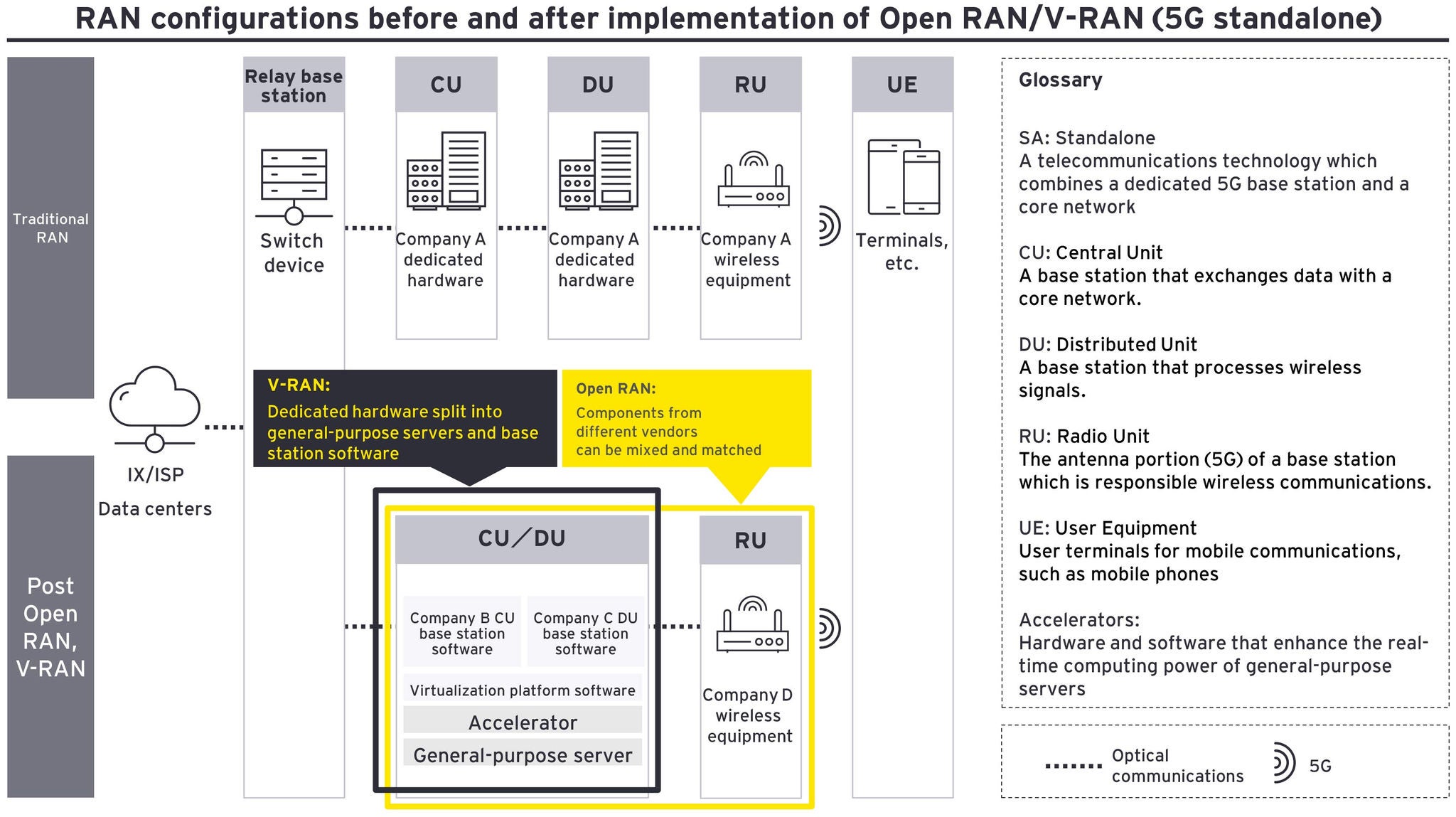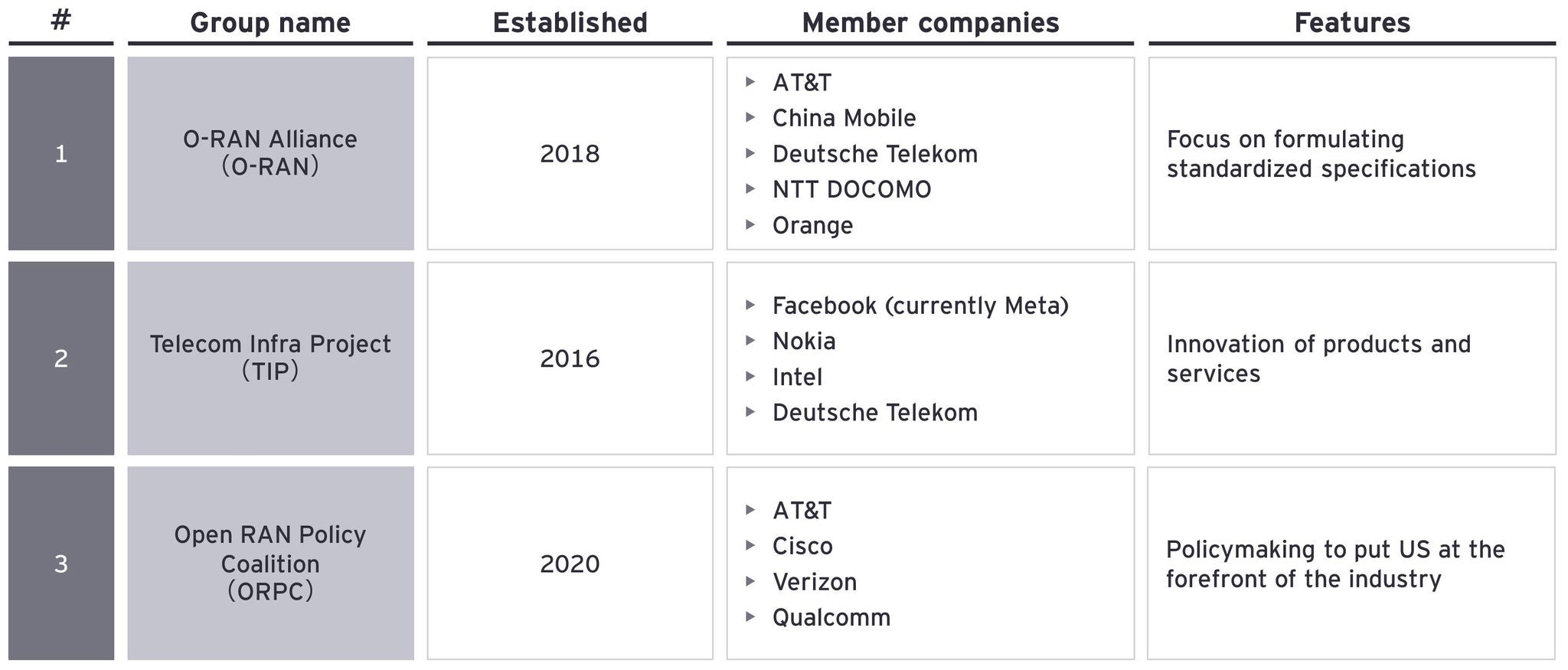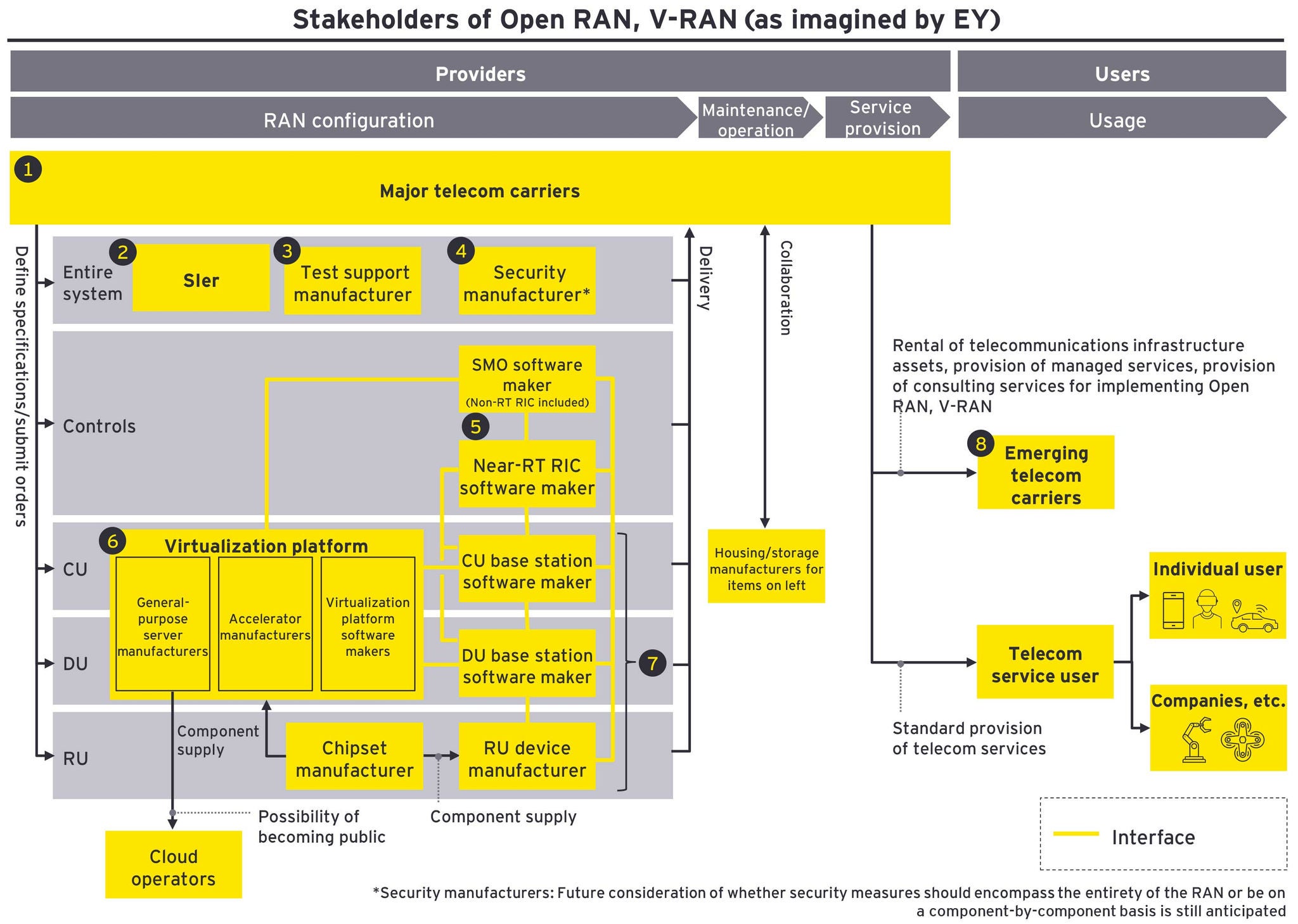EY refers to the global organization, and may refer to one or more, of the member firms of Ernst & Young Global Limited, each of which is a separate legal entity. Ernst & Young Global Limited, a UK company limited by guarantee, does not provide services to clients.

Telecommunications carriers around the world are commencing their trial runs for properly implementing Open RAN and V-RAN technologies, with the expectation that investment outlay on base stations required for mobile networks will be significantly reduced.
This article summarizes the seven key points for popularizing these RAN technologies, and also explores the various new business opportunities that await relevant stakeholders.
In brief
- With the implementation and adoption of Open RAN and V-RAN technologies, telecommunications carriers can expect reductions in capital expenditure costs, operational costs, supply chain risks, and operational risks.
- Especially during these early stages of implementation, we believe the enhancement of initiatives aimed at commercializing the offerings of each technology are the keys to achieving their widespread adoption. These initiatives include enticing as many businesses as possible to form and participate in businesses alliances, as well as the active formulation of specifications and the development of product services.
- The shift to a multi-vendor environment and to software-based systems is expected to present new business opportunities for a wide range of stakeholders.
A radio access network (“RAN”) is a component of a mobile telecommunications network that connects the user’s device with a core network. An open RAN (“Open RAN”) is a type of RAN that allows for a common interface between devices, and a virtualized RAN (“V-RAN”) uses virtualization technology to run base station software on general-purpose servers.
Telecommunications (“telecom”) carriers around the world are commencing their trial runs for properly implementing Open RAN and V-RAN technologies, with the expectation that investment outlay on base stations required for mobile networks will be significantly reduced as a result.
With that said, a multitude of hurdles and issues must still be addressed before the full-scale implementation of Open RAN and V-RAN is realized. Many of the industry’s players are likely keeping their ears to the ground to identify potential business opportunities and the optimal timing for going all in on the technologies.
This article will provide an overview of the current trends of industry groups and industry leaders, further explore what is necessary to popularize Open RAN and V-RAN, and discuss the business opportunities that may lie ahead for stakeholders.
As a side note, the abbreviation “O-RAN” is often used to refer to the industry organization “O-RAN Alliance,” or the specifications defined by the organization. Accordingly, this article will use the term “Open RAN” to refer to an open radio access network and the term “V-RAN” to refer to the virtualization of radio access networks.
1. Benefits of implementing Open RAN and V-RAN
The SA1 technology of the next-generation communication standard 5G2 employs a RAN that connects terminals with the core network. This RAN consists of a CU3 that exchanges data with the core network, a DU4 that processes wireless signals, and an RU5 that handles wireless communications.
Interface specifications between the CU/DU/RU were not standardized in the traditional closed RAN, forcing telecom carriers to procure equipment from the same vendor. In contrast, Open RAN standardizes interface specifications between devices and allows telecom carriers to combine devices procured from different vendors.
In addition, the CU/DU in a traditional RAN were built with dedicated hardware that had embedded software. However, V-RAN allows for the CU/DU to be run with base station software on general-purpose servers, removing the need for dedicated hardware.

In terms of overall global market size, Open RAN is expected to reach approximately USD44.7 billion by 2029, and V-RAN is expected to reach approximately USD7 billion by 2029.6

The Open RAN and V-RAN markets are expected to grow at rapid rates, but how exactly are telecom carriers expecting to benefit from these technologies? We have summarized the most anticipated impacts of each below.
Open RAN
① Reduction of capital expenditure on equipment
Flexibility within the selection process for procuring CU/DU/RU hardware will become possible. Increased competition amongst vendors comes with the industry becoming a multivendor environment, thereby pushing hardware costs down.
② Reduction of operating costs
With a multivendor environment also comes the expectation that more vendors providing low-cost/simple equipment will appear. Telecom carries that adopt simplified equipment rather than high-spec hardware for their CU/DU/RU needs will at the same time simplify their operations, thereby cutting operating costs.
③ Reduction of supply chain risks
A multivendor environment will expand the sources for procuring CU/DU/RU equipment. With so many alternative suppliers available, interruptions to procurement channels, such as product shortages or certain vendors suspending operations, will have negligible impact on the ability to repair or newly install base stations.
④ Reduction of operational risks
With a multivendor environment, when an issue arises with a CU/DU/RU procured from a particular vendor, it is unlikely to have a widespread impact due to each RAN using components from a variety of vendors, thereby limiting the breadth and scope of any mobile service interruptions.
V-RAN
① Reduction of capital expenditure on equipment
CU/DU in a traditional RAN are composed of high-cost, dedicated hardware. V-RAN, on the other hand, is often configured with relatively inexpensive, general-purpose servers and base station software, and the cost savings on both the software and server fronts make the overall cost of implementation significantly cheaper than a traditional RAN. In addition, rather than needing to update or add expensive dedicated hardware when repairs are required, the continued use or addition of inexpensive, general-purpose servers alongside updating the base station software allows for equipment expenditures to be further reduced.
② Reduction of operational costs
The expansion of remote maintenance capabilities that comes with converting CU/DU to software reduces on-site personnel hours and allows for cutting operational costs.
③ Reduction of operational risks
When a specific general-purpose server fails within the CU/DU, a virtual machine automatically launches on another general-purpose server, enabling automatic recovery in a brief period of time.
2. Industry trade groups promoting widespread adoption of Open RAN and V-RAN
In anticipation of the above benefits, various stakeholders (primarily telecom carriers) have formed industry trade groups and are engaged in various initiatives to promote the adoption of Open RAN and V-RAN. We have summarized the characteristics of these key groups below.
① O-RAN Alliance (“O-RAN”) is focused on formulating specification standards
O-RAN Alliance was founded in February 2018 by AT&T, China Mobile, Deutsche Telekom, NTT DOCOMO and Orange. It aims to promote open and intelligent RAN (automatic optimization of networks using RAN Intelligent Controllers) in the 5G era. It has 304 member companies (as of 20 December 2022) and is the largest group in the industry focused on defining specifications. Many of its members promote in-house development of products and services based on the standardized specifications of O-RAN. 7
② Telecom Infra Project (“TIP”) promotes implementation of products and services
TIP was established in 2016 with Facebook (currently Meta) at the center of its community. It aims to apply the trends in the disaggregation and virtualization of RANs to telecommunications infrastructures in order to spur innovations in hardware, software, and operations. Many telecom carriers and equipment vendors are members of both the TIP and O-RAN and are also actively engaged in O-RAN’s efforts to formulate specifications, as well as TIP’s efforts to verify products created based off such specifications (e.g., CU/DU/RU that are interoperable with the communications equipment of other companies). *8
③ The Open RAN Policy Coalition (“ORPC”) crafts policies to build and maintain US technological leadership on a global level
ORPC was established in the United States in 2020 as an organization that reviews policies related to Open RAN specifications. Many of its members companies are also members of O-RAN and TIP. The organization appears focused on conducting policy planning that aims to secure the US’ leading position in high-tech fields.9

3. Initiatives by telecom carriers to stay ahead
Let us take a closer look at exactly what kind of initiatives the members of these groups are engaged in to promote the spread of Open RAN and V-RAN. This section will dive into the activities of NTT DOCOMO and Rakuten Mobile, two companies conducting leading edge initiatives worldwide.
NTT DOCOMO is currently focused on introducing consulting support services for Open RAN and V-RAN applications. It launched the service brand "OREX" as a services package aimed at overseas telecoms carriers to provide support for implementation, operation, maintenance and other aspects of Open RAN and V-RAN. For example, overseas telecom carriers can perform V-RAN verification from their own countries by leveraging the “Shared Open Lab” deployed by OREX. This enables V-RAN verification to proceed quickly and at low cost, without the company needing to build its own lab environment. The company has already provided implementation support to five clients: KT in South Korea, Smart Communications Inc. in the Philippines, Vodafone Group Plc in the UK, DISH Wireless in the US, and Singtel in Singapore (as of 27 February 2023).10
In addition, Rakuten Symphony, a subsidiary of Rakuten Mobile, has launched a service that rents its own virtualization and cloud-native network assets to overseas telecom carriers. This service allows telecom carriers to rent telecommunications infrastructure by utilizing the knowledge gained from Rakuten Mobile’s creation of a fully virtualized and cloud-native network in Japan to build a mobile network called "Rakuten Communications Platform." Telecom carriers can significantly reduce network costs by using this service and can also expect to reduce their capital expenditures when developing their telecom businesses. 1&1 in Germany decided to adopt the service in 2021, and Rakuten Symphony is at the forefront of commercializing the service.11
4. Keys to popularizing Open RAN and V-RAN
As they have until now, industry trade groups and telecom carriers continue taking various steps to popularize the implementation of Open RAN and V-RAN. But what exactly do they need to be aware of when taking the applications of RAN to the next level? We have summarized those key issues below.
Points shared across Open RAN and V-RAN
① Promoting initiatives for the enhancement of alliances and commercial implementation
Open RAN and V-RAN are recent technologies, meaning the key to their widespread adoption is taking advantage of these initial stages of implementation to involve as many business operators as possible in forming businesses alliances, as well as continuing to actively engage in efforts needed for successful commercialization, such as specification formulation and the development of product services. Beyond such efforts, leading Open RAN and V-RAN to their growth stage requires such initiatives to not lose momentum. The introduction of Open RAN and V-RAN must be effective and the market should be able to clearly identify what differentiates them from traditional RAN technology.
② Knowledge/technical proficiency to ensure communication quality
With Open RAN, the combination of equipment from different vendors requires the careful verification of interconnectivity between the equipment and an accelerated improvement cycle. V-RAN also requires the verification of interconnectivity between general-purpose servers/accelerators/virtualization platform software/base station software. If a telecom carrier is technically proficient, it can perform verification on its own and guarantee communication quality. However, not all telecom carriers are capable of this. Even if systems integrators (“SI”) can verify interconnectivity and test support manufacturers can conduct quality tests, the telecom carrier is the party ultimately responsible for guaranteeing the communication quality, and as such is required to have the knowledge and technical proficiency to accept and test incoming products and services.
③ Verification of cost benefits, including for integration
While Open RAN and V-RAN are expected to reduce capital expenditure and operating costs, if equipment from various vendors is adopted for CU/DU/RU, or if base station software is run on general-purpose servers with built-in accelerators, costs will still be incurred for the system integration needed to operate the RAN appropriately. Accordingly, telecom carriers must verify whether cost advantages actually exist compared to the conventional TCO12 which also takes integration into account.
Open RAN
④ Cyber security specific to Open RAN
Compared to traditional RAN, Open RAN has more interfaces (connections) between CU/DU/RU and new components. As a result, there are cybersecurity concerns about Open RAN that did not exist for conventional RAN. It will be necessary to meticulously identify potential security risks and prepare the appropriate security requirements and solutions. More specific considerations will be required in the future, such as whether security countermeasures should be taken for the components of each individual vendor, or whether telecom carriers will take comprehensive measures for the entire RAN on their own.
⑤ Standardization of RAN maintenance and operational procedures
With traditional RAN, specific vendors delivered the CU/DU/RU as a single package, which meant the types of manuals available for maintenance and operations were limited, even across the entire base station. On the other hand, with the adoption of a multi-vendor environment for Open RAN, the entire base station will have multiple manuals from various vendors, causing concern that maintenance and operation will become even more complicated than with traditional RAN. Standardization and the establishment of specification and procedures for maintenance and operation are necessary so that any vendor can potentially be used.
V-RAN
⑥ Improving integration of general-purpose servers and base station software
The combination and connectivity of CU/DU/RU devices are major discussion points for Open RAN. On the other hand, V-RAN requires building and implementing an architecture for hardware and software within the DU equipment in order to process wireless signals. As such, a greater impact on communication quality is expected when compared to Open RAN. For virtualization to become mainstream in the future, it will be essential to improve integration so that it enables base station software to function on general-purpose servers equipped with accelerators, as well as to implement technology that stabilizes communication quality.
⑦ Early defect detection and advance preparation of BCP
Traditional CU/DU were procured from a single vendor, meaning any system interruptions due to defects could be swiftly resolved by vendors familiar with the dedicated hardware they delivered. On the other hand, V-RAN will likely use different vendors for each component, creating concern around the difficulty of identifying where a defect or failure has occurred within the general-purpose servers/accelerators/virtualization platform software/base station software. Accordingly, swift resolution of such instances can only be achieved by designing mechanisms and systems that enable the early detection of defective areas. In addition, it is important to make advance preparations for a business continuity plan (“BCP”), such as preparing manuals that detail response procedures and recovery methods for each specific issue that may arise.
5. New business opportunities brought about by Open RAN and V-RAN
Now that we have reviewed the above key points, let us take a deeper dive into what kind of business opportunities await stakeholders once Open RAN and V-RAN are popularized. With a multi-vendor environment and a shift to software-based systems, the number of participating stakeholders is expected to increase alongside a wide range of new business opportunities. Below is an overview of these potential business opportunities from the lens of each stakeholder.

① Major telecom carriers
- Asset rental of telecommunications infrastructure composed of Open RAN and V-RAN, provision of managed services (aimed at emerging telecom carriers in Japan and/or overseas)
- Implementation consulting services for Open RAN and V-RAN (aimed at emerging telecom carriers in Japan and/or overseas)
② SIer
- Provision of systems integration services to enable end-to-end interconnectivity of control components and CU/DU/RU (including virtualization platforms and base station software embedded in CU/DU)
- Test support manufacturers (emulators, measuring instrument manufacturers, etc.)
- Provision of test services and platforms to enable end-to-end interconnectivity of control components and CU/DU/RU (including virtualization platforms and base station software embedded in CU/DU)
③ Test support manufacturers (emulators, measuring instrument manufacturers, etc.)
- Provision of test services and platforms to enable end-to-end interconnectivity of control components and CU/DU/RU (including virtualization platforms and base station software embedded in CU/DU)
④ Security manufacturers
- Provision of security solutions that comply with cybersecurity requirements, such as the use of encrypted communications, mutual authentication using certificates, and the use of SBOM.
(future consideration of whether security measures should encompass the entirety of the RAN or be on a component-by-component basis is still anticipated)
⑤ SMO13 Software makers (Non-RT RIC14, Near-RT RIC15 Software makers)
- Provision of software that utilizes artificial intelligence/machine learning to optimize CU/DU parameter settings and improve operational efficiency with respect to the wireless environment and traffic load
⑥ Manufacturers of hardware and software that compose the virtualization platform
- Provision of a general-purpose servers for running the CU/DU base station software
- Provision of accelerators to enhance the real-time computing power of general-purpose servers
- Provision of software that connects to a general-purpose server and creates multiple partitioned environments (virtual machines) from a single system
⑦ CU/DU base station software manufacturers, RU equipment manufacturers
- Provision of base station software to fulfill the functions of CU, which exchange data with the core network, and DU, which process wireless signals
- Provision of equipment to fulfill the functions of RU, which are responsible for wireless communications
⑧ Emerging telecom carriers
- Ability to newly enter the telecommunications business using the telecommunications infrastructure asset rental services provided by the major telecom carriers, as described above (while also keeping capital expenditures for base stations low)
6. Closing thoughts
In this article we leveraged the knowledge obtained from a variety of sources, such as interviews with experts and case studies of current overseas and Japanese initiatives, to dissect what exactly is required for the popularization of Open RAN and V-RAN, as well as what new business opportunities await relevant stakeholders. Especially during these initial stages of implementation, we believe the enhancement and promotion of initiatives necessary for successfully commercializing the offerings of each technology are the keys to achieving their widespread adoption. These initiatives include enticing as many businesses as possible to form and participate in businesses alliances, as well as active formulation of specifications and the development of product services. We at EY believe such efforts will lead to a wide breadth of new business opportunities being available to stakeholders in the future.
If you happen to be such an industry member looking for potential business opportunities, we hope this article can serve as reference to consider how your company’s capabilities can be leveraged to bring about these lucrative opportunities in your respective business ventures.
Article references
1. SA technology: Short for standalone technology. A telecommunications technology which combines a dedicated 5G base station and a core network
2. 5G: Abbreviation for 5th Generation. The primary features of 5G are high speeds, large capacity, low latency, and multiple simultaneous connections.
3. CU: Short for central unit, a base station that exchanges data with a core network.
4. DU: Short for distributed unit, a base station that processes wireless signals.
5. RU: Short for radio unit, the antenna portion of a base station which is responsible wireless communications.
6. QYReseach, Global O-RAN Market Report (2023)
QYReseach, Global Virtualized Radio Access Network (vRAN) Market Report (2023)
7. O-RAN ALLIANCE、o-ran.org (accessed on 4 July 2023)
8. Telecom Infra Project、telecominfraproject.com (accessed on 4 July 2023)
9. Open RAN Policy Coalition、openranpolicy.org (accessed on 4 July 2023)
10. NTT DOCOMO: "Over five foreign telecom carriers receive support from DOCOMO for moving towards Open,” docomo.ne.jp/binary/pdf/info/news_release/topics_230227_00.pdf (accessed 4 July 2023)
11. Rakuten: “Building a mobile network with German wireless provider 1&1,” corp.rakuten.co.jp/news/press/2021/0804_03.html (accessed 4 July 2023)
12. TCO: Short for total cost of ownership. Usually refers to the general amount of costs for the implementation and operation of IT systems. For the purposes of this article, refers to the general amount of costs for the implementation and operation of RAN.
13. SMO: Service Management and Orchestration - Components for RAN monitoring, maintenance, and orchestration (managing RAN resources and network connectivity)
14. Non-RT RIC:Non Real Time RAN Intelligent Controller - a component within the SMO that optimizes CU/DU parameter settings and improves operational efficiency.
15. Near-RT RIC:Near Real Time RAN Intelligent Controller - a component that controls the CU/DU in accordance with the control policy received from the Non-RT RIC
【Co-authors】
EY Strategy and Consulting Co., Ltd.
Technology, media and entertainment, and telecommunications (TMT) Sector
Mikio Mizushima - Senior Manager
Masaya Kobayashi - Manager
Minoru Hotta – Consultant
Intelligence Unit
Tetsuo Kan - Consultant
*Above ranks and affiliations reflect those at the time this article was published.
Summary
Telecommunications carriers around the world are actively commencing their trial runs for a proper roll-out of Open RAN and V-RAN technologies. At EY, we have used the knowledge obtained from interviews with experts and case studies of current overseas and Japanese initiatives to examine seven key points necessary for popularizing these technologies, as well as to identify new business opportunities that await relevant stakeholders.

